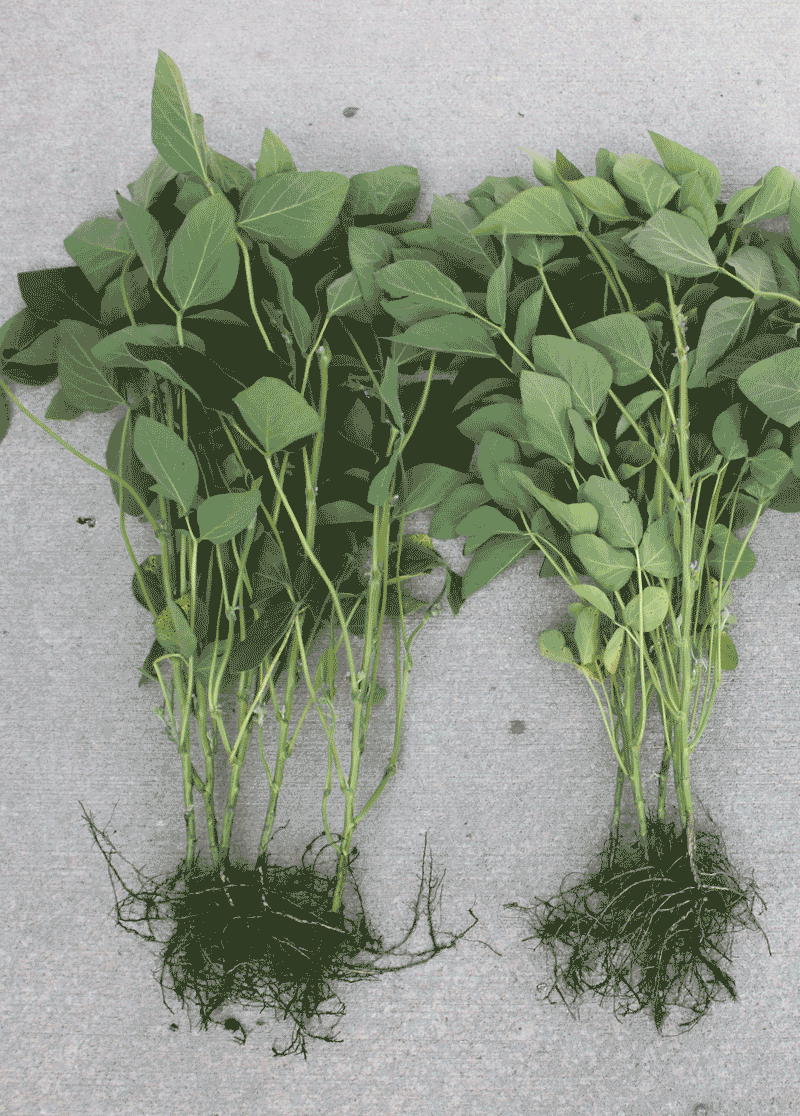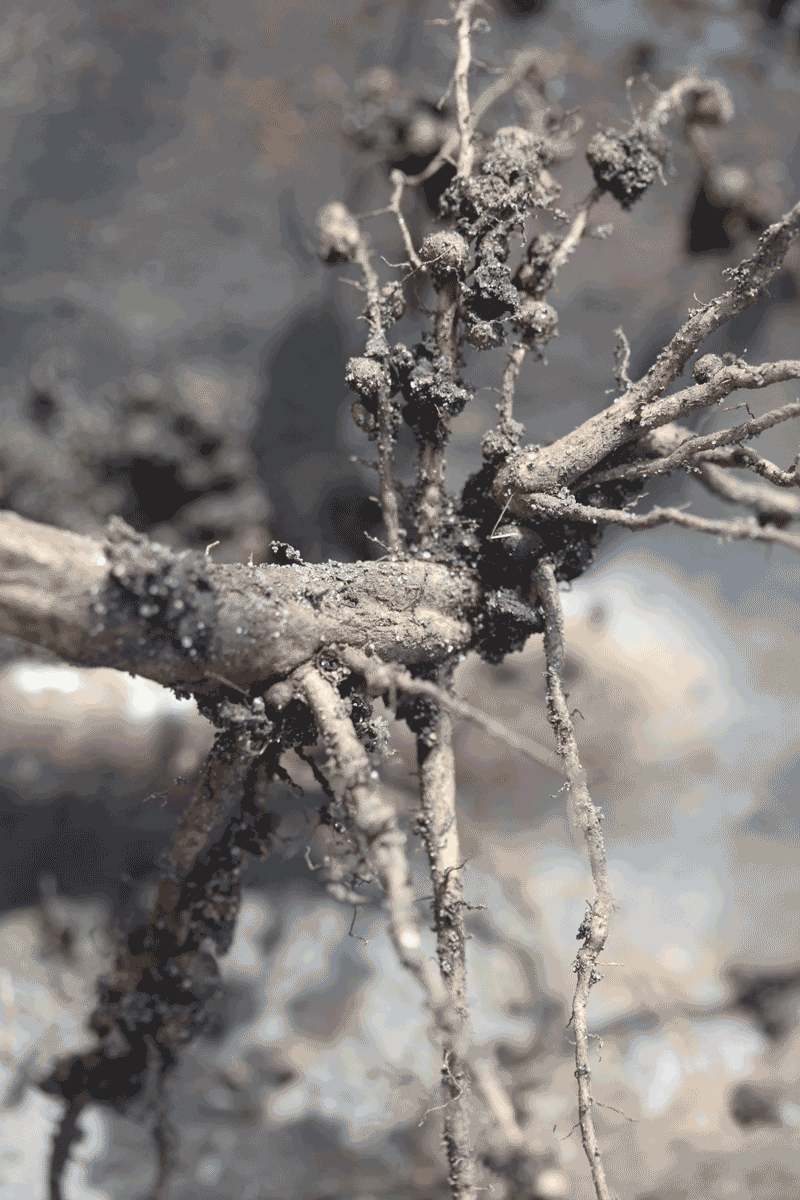Robust SCN management
PREVENTING YIELD LOSS
FOR MANY SOUTHWESTERN Ontario growers, Soybean Cyst Nematode (SCN) is a reality that’s been around for a while. But, understanding the spread of this illusive pest, how to spot it, and how to manage it can still be masked in mystery. Growers may have up to 30 per cent yield loss from SCN without even knowing it.
PHOTO: CLARIVA PN VS. CHECK. CLARIVA PN SEED TREATMENT HELPS TO ENHANCE THE PERFORMANCE OF SCN RESISTANT SOYBEAN VARIETIES.

PHOTO: SCN INFESTED SOYBEAN ROOT.

Without a doubt, SCN is spreading further north and east in Ontario. What used to be a problem for a few farms in the deep southwest now has growers as far northeast as Kincardine scratching their heads. The initial mapping of SCN in Ontario was done in 2011 by Agriculture and Agri-Food Canada (AAFC). Showing SCN prominent in Essex and Chatham-Kent with positive samples in Middlesex, Lambton, and Elgin, this project was important in tracking the spread of the pest.
Acting on insight from 2012 updates by AAFC to the mapping project, Syngenta did some testing in 2014 – 225 samples across Ontario — focused in non-traditional areas to see if SCN had spread further since the initial mapping work. The sampling found growing ‘hot spots’ in Huron County that demonstrate that SCN has spread far up the coast of Lake Huron.
WHAT TO LOOK FOR?
Anything — natural or man-made — that moves soil will help SCN continue its march into new territories. Wind erosion and animals can be sources of SCN movement but the main culprit is farm equipment movement.
The obvious symptoms of an SCN infestation are circular patches within the field where beans are stunted and yellowed. Some diseases can also be a sign of SCN. Sudden Death Syndrome often appears in SCN infected areas. The cysts open up an entry point in the root for the disease to enter the plant and take hold.
Unfortunately, SCN can rob yield even before the symptoms become obvious. Moderate SCN symptoms are easy to misdiagnose as other production issues and can be easily explained away as ‘it’s just the type of season we’re having’.
The best time to diagnose SCN is at harvest. Pay close attention to the yield monitor and note areas in the field where yield is dipping that don’t make sense with the field’s history. Pay extra attention to field entrances where equipment is moving in and out of the field, as these are often entry points for SCN.
If you do identify low yielding spots that don’t quite make sense, resist the urge to brush it off as a “quirk of the field” or a result of the weather this season. Take a soil sample and get it tested for SCN. After harvest is an excellent time to do soil tests for SCN since egg and cyst counts should be at their highest. You can also look at the roots of plants in the affected area. Wash off the soil and use a hand magnifying glass to identify the cysts. But, beware of relying on simple visual analysis; even when you don’t see cysts, a soil sample may reveal that SCN is present in the field.
GENETIC MANAGEMENT
The most common management strategy for SCN today is planting soybean varieties that are genetically resistant to SCN. There are two main sources of genetic resistance used commercially by plant breeders in eastern Canada: PI88788 and Peking. These naturally occurring genetic sources are bred into varieties using conventional breeding techniques. While two sources are used, PI88788 is much more common — it’s used in more than 98 per cent of all SCN- resistant varieties.
“PI88788 is much easier to work with compared to Peking and other sources of resistance,” explains David Lee, soybean breeder with Syngenta Canada. “These genetic sources of resistance help reduce feeding of specific races of SCN on the soybean. A soybean variety classified as resistant must show 10 cysts per plant or fewer. Moderately resistant varieties can have up to 30 cysts per plant,” says Lee.
While these sources of resistance are incredibly important in managing SCN, they do have limitations. “PI88788 only protects against SCN races three and 14 while Peking protects against SCN races one, three, and five and some varieties contain both sources of resistance,” says Lee. “Over several years SCN races can shift. If that happens, the industry’s currently resistant varieties become less effective,” he continues.
NEW MANAGEMENT OPTIONS INTRODUCED
A shift in the virulence and the spread of SCN has many growers looking more holistically at their SCN management plans and wondering if there is something else they can do. Using nematicides for better control of SCN is growing in interest.
Syngenta is introducing a new seed treatment for SCN for the 2016 planting season known as Clariva pn. It contains the Pasteuria nishizawae bacteria as its active ingredient. When Clariva pn treated seed is planted, the P. nishizawae spores are released into the soil and establish a protective zone around the young soybean plant’s roots.
The P. nishizawae spores infect, and eventually kill, SCN that come into contact with plant roots by curbing their ability to feed and reproduce. As the remnants of the nematodes decompose, the spores are released back into the soil to provide season-long activity and suppression.
SCN resistant varieties will still be integral in a management plan but growers can plug some of the holes that genetics alone leaves for more robust management of SCN.
About the author: Shawn Brenneman is the agronomic services manager at Syngenta and a certified crop advisor.
Crop advisors provide advice and council producers in their decision making process. This responsibility requires a good understanding of science, food safety, technology, economics and environment. Crop advisors combine knowledge in these disciplines with their local experience to render sound recommendations.
If you would like to contact a CCA in your area or if you would like contact information for any of the above mentioned CCAs, please contact the CCA office at (519) 669-3350 or visit the website at www.ccaontario.com.
TIPS TO REMEMBER
• Rotate your crops — plant non-host crops like corn or wheat in between soybeans.
• Manage weeds — certain weeds also act as hosts for SCN. Be sure to control weeds like chickweed, shepherds purse, henbit, and purslane.
• Sanitize equipment — be sure to clean equipment of soil before transferring it to uninfected fields.
• No-till — SCN will stay localized within a field unless the soil is physically moved. Limit soil disruption with no-till practices.
• Plant clean certified seed — good quality certified seed will be free of dirt which can spread SCN.
• Select varieties that contain genetic resistance to SCN.
• Ask your seed dealer or commercial treater about nematicide seed treatment options. •






















